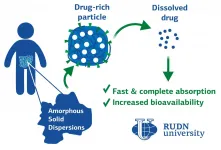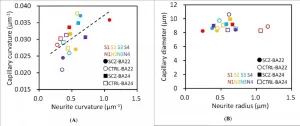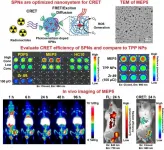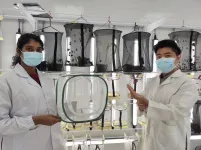RUDN University scientists in pharmaceutical technology proved effectiveness of new dosage form
2021-06-14
(Press-News.org) RUDN University scientists together with colleagues from Switzerland proved in a clinical trial the effectiveness of a new dosage form -- amorphous solid dispersion. This is the first such study in humans to show the mechanism of action of this form of drug release. In the future, it will help to increase the effectiveness of drugs and use new active substances for treatment. The results of the study are published in Pharmaceuticals.
One of the main reasons for the dropout of new oral drugs at the preclinical and clinical stages of development is low bioavailability. The drug itself can be effective, but it is poorly absorbed in the body because of its low solubility. Amorphous solid dispersion (ASD) is a new form of drug release that has the potential to solve this problem. ASD consists of a drug substance and a polymer framework that "binds" the drug and improves its solubility, thus increasing bioavailability. RUDN University scientists in the field of pharmaceutical technology, together with colleagues from Switzerland, conducted a clinical study and proved the effectiveness of ASD. This is the first such human trial.
"Despite the research effort on mechanisms of increased bioavailability through ASDs during the last decades, these mechanisms are far from being understood in every detail. Furthermore, the translation from preclinical studies to clinical outcomes in humans has not been validated. This clinical study aimed to investigate the mechanisms and effects of a particle forming ASD on bioavailability in humans to understand the complex absorption from ASDs in humans. To our best knowledge, there are currently neither documented data nor methods providing such insights", Rimma Abramovich, Doctor of Pharmaceutical, Director of the Shared Research and Education Center of the RUDN University
The clinical study involved 16 volunteers; healthy men aged 20 to 38 years. As a model medicine, doctors used the antiviral drug efavirenz, which is used in the treatment of HIV infection. Participants in the study took efavirenz orally in three different forms in three interventions -- 50 mg in the form of solid ASD, 50 mg in the form of dissolved ASD, and 3 mg of a molecular solution of efavirenz. To avoid distortion of the results, doctors maintain a washout period of 14 to 21 days. After each intervention, the doctors took a blood test and measured the pharmacokinetic profile -- the dynamics of efavirenz concentration in blood plasma over time.
It turned out that ASD in solid form works in the same way as a regular efavirenz tablet -- the maximum concentration of about 6.5 nanograms per milliliter is reached in two hours. And the dissolved ASD acts as a molecular solution of the drug -- the concentration of the drug in the blood reached approximately the same value after the same time -- about 10 nanograms per milliliter after 50-60 minutes. However, given that the molecular solution is absorbed from the intestine into the blood passively (that is, without additional chemical reactions), the scientists calculated that the actual concentration of the drug in the intestine in the case of dissolved ASD is 16.7 times higher than in the case of conventional efavirenz. This means that the dissolved ASD behaves like a so-called supersaturated solution; meaning that it contains 10 times more dissolved matter than it can dissolve under normal conditions.
"We could show that drug absorption from drug-rich particles, formed upon the dissolution of the ASD, was fast and complete in humans", Rimma Abramovich, Doctor of Pharmaceutical, Director of the Shared Research and Education Center of the RUDN University.
INFORMATION:
[Attachments] See images for this press release:

ELSE PRESS RELEASES FROM THIS DATE:
2021-06-14
The 17-year cicadas emerging dramatically by the billions in 15 U.S. states from Georgia to New York and west to Illinois are making quite a racket--a uniquely North American phenomenon--but thousands of other cicada species on the planet also spend most of their lives underground, many of them emerging below the radar of human perception. Because most cicada species don't emerge simultaneously like species in the genus Magicicada--the periodical cicadas--little is known about their natural history. Driven by unusual attention to detail and curiosity, Annette Aiello, staff entomologist at the Smithsonian Tropical Research Institute (STRI) in Panama, joined a very select group of ...
2021-06-14
Environmental bacteria and fungi that end up in the belly of honeybees may be essential to their survival in a changing world as bee populations dwindle due to pesticides, poor nutrition, habitat destruction and declining genetic diversity.
Like many animals, bees have an internal armory. Their guts are home to a multitude of microbes that perform vital functions, from aiding digestion to breaking down toxins and fending off parasites. "A healthy gut microbiota makes bees more resilient to threats such as pathogens and climate change," says KAUST research scientist Ramona Marasco, "highlighting the need to understand how different microbes help their host."
Extensive research into the microbiome ...
2021-06-14
Some 42% of patients attending a dedicated diabetes clinic have signs of established chronic kidney disease, the first detailed research of its kind in Ireland has revealed.
The study was carried out by academics at NUI Galway and clinicians at University Hospital Galway Diabetes Centre and involved more than 4,500 patients in the west of Ireland.
The findings suggest that, despite careful medical management, a relatively high proportion of people with diabetes in Ireland are developing chronic kidney disease over time and are at risk of kidney failure and other complications of poor kidney function.
Diabetes ...
2021-06-14
Drs. Itokawa, Mizutani and colleagues performed microtomography experiments the BL20XU beamline of the SPring-8 synchrotron radiation facility and found that brain capillary structures show a correlation with their neuron structures.
Brain blood vessels constitute a micrometer-scale vascular network responsible for supply of oxygen and nutrition. In this study, we analyzed cerebral tissues of the anterior cingulate cortex and superior temporal gyrus of schizophrenia cases and age/gender-matched controls by using synchrotron radiation microtomography or micro-CT in order to examine the three-dimensional structure of cerebral vessels.
All post-mortem human cerebral tissues were collected ...
2021-06-14
A new species of large prehistoric croc that roamed south-east Queensland's waterways millions of years ago has been documented by University of Queensland researchers.
PhD candidate Jorgo Ristevski, from UQ's School of Biological Sciences, led the team that named the species Gunggamarandu maunala after analysing a partial skull unearthed in the Darling Downs in the nineteenth century.
"This is one of the largest crocs to have ever inhabited Australia," Mr Ristevski said.
"At the moment it's difficult to estimate the exact overall size of Gunggamarandu since all we have is the back of the skull - but it was big.
"We estimate the skull would have been at least 80 centimetres long, and based on comparisons with living crocs, this indicates a total ...
2021-06-14
Summer picnics and barbecues are only a few weeks away! As excited as you are to indulge this summer, Escherichia coli bacteria are eager to feast on the all-you-can-eat buffet they are about to experience in your gut.
However, something unexpected will occur as E. coli cells end their journey through your digestive tract. Without warning, they will find themselves swimming in your toilet bowl, clinging to the last bits of nutrients attached to their bodies. How do these tiny organisms adapt to survive sudden starvation? Scientists at Washington University in St. Louis wondered.
Close examination of nutrient-deprived E. coli ...
2021-06-14
Reston, VA (Embargoed until 12:30 p.m. EDT, Monday, June 14, 2021) - Researchers have successfully developed a novel cancer treatment approach that utilizes Cerenkov radiation energy to target and destroy cancer cells more effectively. The approach uses light from decaying radiopharmaceuticals, known as Cerenkov luminescence, as an energy source to activate semiconducting polymer nanoparticles that kill cancer cells. This research was presented at the Society of Nuclear Medicine and Molecular Imaging's 2021 Virtual Annual Meeting.
Over the past several decades, many studies have been conducted on photodynamic therapy, ...
2021-06-14
Alzheimer's disease is the most common form of dementia and is characterized by neurodegeneration in regions of the brain involved in memory and learning. Amyloid beta and tau are two toxic proteins that build up in disease and cause eventual neuronal death, but little is known about how other cells in the brain react during disease progression.
A new study from the ASU-Banner Neurodegenerative Research Center (NDRC) and MIT/Koch Institute sheds new light on how disease processes manifest in patients with Alzheimer's disease.
Diego Mastroeni of the NDRC teamed up Forest White and Douglas Lauffenburger, colleagues in MIT's Department of Biological Engineering, to explore how protein ...
2021-06-14
Osaka, Japan - Researchers from the Graduate School of Engineering and the Center for Quantum Information and Quantum Biology at Osaka University unveiled a new solid state second-harmonic generation (SHG) device that converts infrared radiation into blue light. This work may lead to a practical daily-use deep ultraviolet light source for sterilization and disinfection.
Recently, deep ultraviolet (DUV) light sources have been attracting much attention in sterilization and disinfection. In order to realize a bactericidal effect while ensuring user safety, a wavelength range of 220-230 nm is desirable. ...
2021-06-14
Singapore, 14 June 2021 - Many butterfly species bear distinct circular markings known as eyespots on their wings, and the functions of these rings of contrasting colours vary. A long-standing theory is that they serve as anti-predator defences - small eyespots along the wing margin can protect butterflies by directing predators to attack less important parts of the body, such as the hindwings, enabling them to escape.
Most nymphalid family butterflies have half as many eyespots on their forewings compared to their hindwings. In particular, this has been observed in the bush brown butterfly Bicyclus anynana.
A recent research by biologists from the National University of Singapore (NUS) sought to understand the impact of uneven distribution of eyespots. ...
LAST 30 PRESS RELEASES:
[Press-News.org] RUDN University scientists in pharmaceutical technology proved effectiveness of new dosage form








